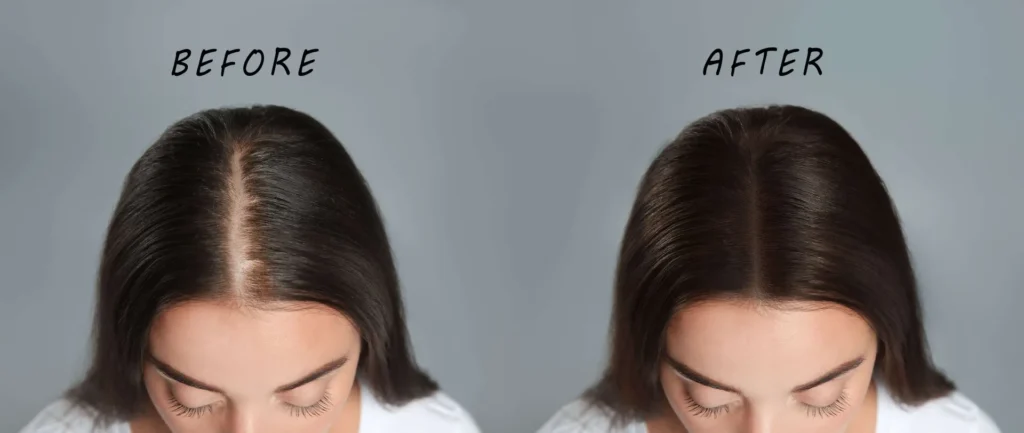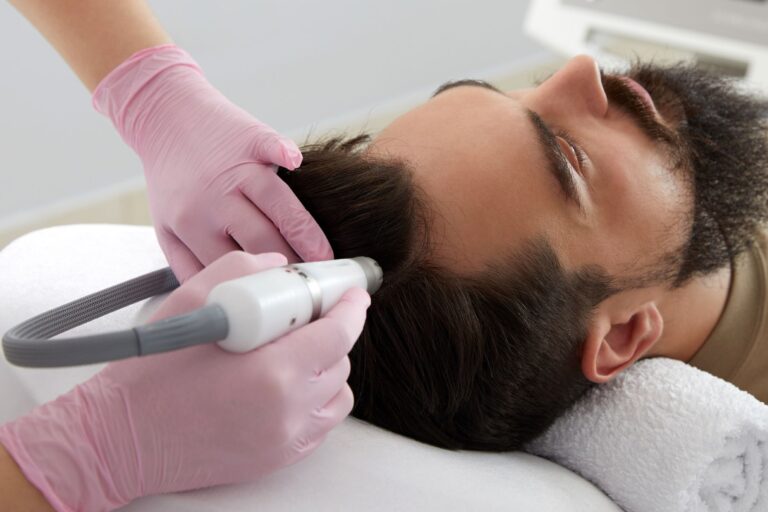
Platelet-Rich Plasma (PRP) hair treatment is gaining popularity as a natural and effective way to fight hair loss. If you’re considering this treatment, you might be wondering, “How long does it take to see results from PRP hair treatment?” This article will answer that question and give you a clear understanding of what to expect.
PRP is commonly used to treat androgenetic alopecia (male and female pattern baldness) and hair thinning. It’s a safe, minimally invasive procedure with little downtime. For best results, 3–4 initial sessions followed by maintenance treatments every 4–6 months are recommended. PRP can be combined with other treatments for enhanced effectiveness.
What is PRP Hair Treatment?
PRP hair treatment is a procedure that uses your own blood to stimulate hair growth. It involves drawing a small amount of blood, processing it to concentrate the platelets, and then injecting it into the scalp. The platelets release growth factors that help repair and rejuvenate hair follicles, leading to thicker and healthier hair over time.
How Does PRP Hair Treatment Work?
PRP hair treatment works by drawing a small amount of the patient’s blood, processing it to concentrate platelets, and injecting the platelet-rich plasma into the scalp. The growth factors in PRP stimulate hair follicles, improve blood circulation, and promote natural hair regrowth, making hair thicker, stronger, and healthier over time.
- Blood Draw: A small amount of blood is taken from your arm.
- Centrifugation: The blood is placed in a machine that spins it at high speed to separate the platelets from other components.
- Injection: The concentrated platelets are injected into areas of the scalp experiencing hair thinning or hair loss.
When Will You Start Seeing Results From PRP Hair Treatment?
PRP hair treatment results vary, but most patients notice improvements within three to six months. Initially, in the first month, shedding may reduce, and hair texture may improve. By three months, hair appears thicker, with enhanced strength and density. Around six months, visible regrowth occurs in thinning areas, with stronger, healthier strands. Full results typically develop within nine to twelve months, depending on individual response and consistency with sessions. Since PRP stimulates existing follicles, multiple treatments (3–4 initially, followed by maintenance every 4–6 months) are essential for sustained growth. Combining PRP with a healthy lifestyle further enhances results.
Results from PRP hair treatment vary by individual, but most patients begin to notice improvements within three to six months after starting the treatment.
1 to 2 Weeks After PRP Treatment
You may experience mild swelling, redness, or tenderness in the treated areas.
Some people notice a slight shedding of old hair, which is normal and temporary.
1 Month After PRP Treatment
The scalp starts to absorb the growth factors from PRP.
Some people notice less hair shedding.
Hair texture may begin to improve slightly.
2 to 3 Months After PRP Treatment
Hair fall decreases significantly.
New hair growth may start, though it may be very fine and hard to notice.
Existing hair becomes stronger and healthier.
4 to 6 Months After PRP Treatment
Visible improvement in hair thickness and density.
Baby hairs start growing in previously thinning areas.
Hair strands become stronger and more resilient.
6 to 12 Months After PRP Treatment
Significant hair regrowth is visible.
Bald spots or thinning areas appear fuller.
Continued improvement in hair strength, thickness, and volume.
Factors That Affect PRP Hair Treatment Results
Several factors influence PRP hair treatment results. Hair loss severity plays a key role—PRP works best for early-stage hair thinning but is less effective for advanced baldness. Overall health and conditions like hormonal imbalances, anemia, or thyroid disorders can impact hair regrowth. Lifestyle choices, including diet, stress levels, smoking, and alcohol consumption, also affect results. Consistency with treatment is crucial, as multiple sessions (3–4 initially, with maintenance every 4–6 months) yield better outcomes. Additionally, the clinic’s expertise and PRP preparation method influence effectiveness. A combination of PRP with medications like minoxidil or finasteride can further enhance hair restoration results.
- 1. Age
Younger individuals may see faster results because their cells regenerate more quickly.
- 2. Severity of Hair Loss
People with mild to moderate hair loss usually respond better than those with severe baldness.
- 3. Overall Health
Good nutrition, hydration, and overall health can impact how well PRP works.
- 4. Frequency of Treatment
Following the recommended treatment schedule ensures optimal results.
- 5. Lifestyle Habits
Avoid smoking, excessive alcohol, and stress, as these can slow down hair regrow
Who is a Good Candidate for PRP Hair Treatment?
A good candidate for PRP hair treatment is someone experiencing early-stage hair thinning or mild to moderate hair loss, particularly due to androgenetic alopecia (male or female pattern baldness). Individuals with active hair follicles respond best to PRP, as it stimulates existing follicles rather than creating new ones. Those with stress-related, postpartum, or traction alopecia may also benefit. Ideal candidates should be in good overall health, free from conditions like blood disorders, autoimmune diseases, or severe scalp infections. PRP is less effective for completely bald areas. Realistic expectations and commitment to multiple sessions improve the likelihood of successful results.
Early-stage hair thinning or hair loss.
Androgenetic alopecia (male or female pattern baldness).
Hair loss due to stress, illness, or surgery.
No severe underlying medical conditions affecting hair growth.
Benefits of PRP Hair Treatment
PRP hair treatment stimulates natural hair growth, reduces thinning, and strengthens existing hair. It’s a non-surgical, safe procedure with minimal downtime. PRP improves scalp circulation, enhances hair density, and supports follicle health. Using the body’s own platelets, it minimizes side effects and offers a natural solution for hair restoration.
-
Natural Solution: Uses your own blood, reducing the risk of side effects.
-
Safe and Effective: Clinically proven to promote hair regrowth.
-
Minimally Invasive: No surgery or long recovery periods.
-
Boosts Hair Health: Improves hair thickness, strength, and shine.
How to Maximize PRP Hair Treatment Results
To maximize PRP hair treatment results, it’s important to follow a comprehensive approach that enhances hair growth and scalp health. PRP works by stimulating hair follicles, but its effectiveness depends on lifestyle choices, proper hair care, and consistency with follow-up treatments.
A key factor is completing the recommended sessions as advised by your specialist. Typically, PRP requires an initial set of 3–4 treatments spaced a month apart, followed by maintenance sessions every 4–6 months to sustain hair growth. Skipping sessions or stopping treatment early can lead to suboptimal results
- Stay Consistent: Complete all recommended sessions.
- Eat a Healthy Diet: Include protein, vitamins, and minerals that support hair growth.
- Use Gentle Hair Products: Avoid harsh chemicals that can weaken hair.
- Reduce Stress: Practice relaxation techniques to prevent stress-related hair loss.
- Avoid Smoking and Alcohol: These can slow down healing and hair growth.
Conclusion: How Long Does It Take to See Results from PRP Hair Treatment?
PRP hair treatment is a promising option for those struggling with hair loss. While results are not immediate, most people start seeing improvements within 3 to 6 months, with significant growth after 6 to 12 months. Staying consistent with treatments and maintaining a healthy lifestyle can help you achieve the best possible outcome.
If you’re considering PRP hair treatment, consult a qualified doctor to see if it’s right for you. With patience and the right care, you can enjoy fuller, healthier hair over time!

